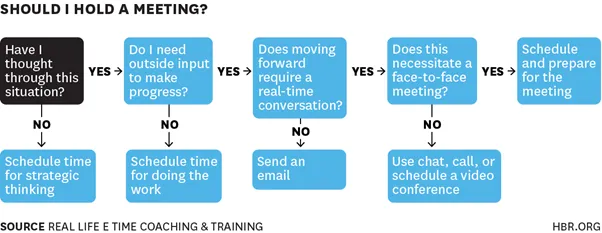You know those meetings that could have been a phone call, or email – or perhaps were not even necessary at all?

Many people complain about work meetings, and feel they could get more work done if they weren’t forever sitting in a room (or behind a Zoom-enabled computer screen) attending meetings that don’t seem to lead to meaningful outcomes.
Meetings aren’t the problem; poorly-run meetings are the problem
A lot of people just blame the meetings. Too many, they say. Unnecessary. Unhelpful.
I disagree. In my opinion, the issue is not ‘too many’ meetings. I think these people have been attending ‘bad’ meetings – meetings with no clear purpose, structure, or desired outcomes.
I believe meetings are effective when they are propel our work forward, when key issues are resolved, or decisions are made.
In this article I make the case for ‘good’ meetings, and share my ideas about:
- How to set up and run meetings that are effective
- How to contribute to meetings meaningfully as an attendee.
The tips I canvass below apply equally to in-person and virtual meetings.
How to set up an effective meeting that achieves positive outcomes

Source: https://hbr.org/2015/03/do-you-really-need-to-hold-that-meeting
There are many facets to setting up a good meeting, and the best way to do it depends on the purpose of the meeting.
(Note: setting up effective board and formal committee meetings are more complex and usually involve statutory, fiduciary and compliance requirements. These types of meetings are beyond the scope of this article.)
Mary Haines shares some general, high-level advice for setting up a general business meeting.
First decide if you need a meeting. The decision tree above from the Harvard Business Review can help you determine if setting up a meeting is really required.
Set a clear purpose for the meeting. Anthony Tjan argues that, outside of general relationship building, there are only three functional purposes for having a business meeting: to inform and bring people up to speed, to seek input from people, or to ask for approval. Determine what the purpose of your meeting is and write it down, up front for all to see, at the beginning of your agenda.
Choose the right attendees depending on the purpose of your meeting. What contribution do you expect from each attendee? I chaired a meeting recently with five attendees. I knew exactly what contributions I hoped for from each person, and I explained that to them – so they each knew what I wanted from them. If you cannot think of an explicit reason to invite someone, that can be a clear signal that they need not attend. A useful rule of thumb is that if you must solve a problem or make a decision then eight or fewer attendees is ideal. If you need to brainstorm, then aim for up to 18 attendees.
Prepare a focused agenda. The best agendas for meetings I attend have items that are directly linked to the purpose, and associated meeting papers. I also like to see indicative time allocated to each agenda item, plus a note explaining if the item is for information, discussion or decision. Some agendas also note the desired outcome for each agenda item. This makes it so easy for attendees, and helps use time efficiently.
Select the right chair. (Not the type you sit on – although that helps too!) Make sure the chair of the meeting is well briefed on your purpose and knows what outcomes you are looking for.
Create the right tone. Once the chair is briefed on the purpose and the attendees, they can set the tone for the meeting which will depend on whether the meeting is to inform, seek input or ask for approval.
How to contribute meaningfully to a meeting as an attendee – Mary Haines’ five Ps
Many times, you are invited to meetings set up by others. Attending meetings hosted by others is a great opportunity for you to contribute to the agenda and demonstrate your professional expertise.
I call the best way you can contribute to meetings the five Ps.
Prepare. Read the papers and agenda in advance. If you do not know who the other attendees are, find out. Look them up on your internal directory, LinkedIn – or Google. It is important to know who else is attending and what their expertise is
Precision. Really zero in on where you can add value. After your preparation, think about exactly how you can contribute to the issues on the agenda. Why were you invited? What are they expecting from you? Can you provide expert insight? Can you add an idea building on what is already in the papers? Can you connect attendees up with others internally or externally who can help?
Be punctual, positive and polite. Your behaviour in meetings is crucial. Everyone is scanning about to ‘read the room/video call’ – you want people to see you as a contributor. People form a view about your competency and professionalism based on your behaviour in meetings. It sounds obvious, but being punctual, positive and polite in meetings shows respect to the chair and other attendees, but also signals your professional maturity. This doesn’t mean never disagree – robust discussion and disagreement are part of healthy meetings. When I am chairing meetings, I sometimes ask if anyone has a ‘minority view’, to encourage all views. Disagreeing is very different to being rude. Stick with these 3 Ps and you can be as ‘robust’ as you like.



